How to Stir Fry
A stir fry is probably the easiest form of cooking that one can begin with. They are technically unchallenging, incredibly forgiving, and are very easy to make changes to as you cook. As the name suggests, you physically stir the ingredients in the pan as they are being fried by a light amount of oil. This constant movement allows the ingredients to heat evenly, brown on all surfaces, and keeps the food from burning because of an even distribution of heat.
Most people associate stir fry with Chinese food. But, this is only partially correct. Chinese food is made with a technique that would be better classified as a Chinese fry. Stir fries may be made with any variety of ingredients and is limited only to your imagination.
I typically use a stir frying technique when I am creating the vegetable and stock bases for my sauces and soups. A stir fry may be cooked any where from a low-heat to a high-heat. You may also use any thickness of ingredients that you choose. But for best results, keep the ingredients within the bite size range.
How to Use the Sauté Pan
The most important technique to know with a sauté pan is the wrist flip. A wrist flip is where you flip the ingredients in a pan, solely by moving the pan forwards and then backwards. This causes the ingredients to move to the front of the pan, fly up and out of the pan, and then back down into the back of the pan. Most commonly this is associated with sautéing, but is primarily used in the stir fry technique. Visually this technique is incredibly impressive. But, it does take some practice even
though it is very easy to master.
Note: This can only be done with a sauté pan that has rounded edges.
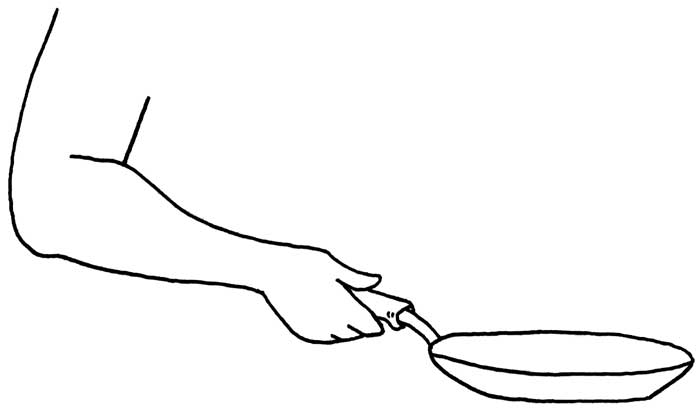
1 Firmly grasp the handle of your sauté pan.
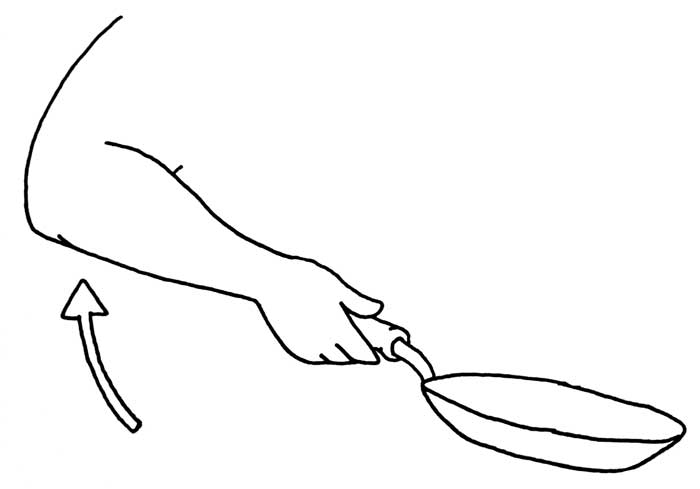
2 Lightly raise the rear of the pan and lower ever so slightly the front of the pan. Take care to keep the pan over your heat source.
3 Move your wrist forwards with medium force, about 6 inches.
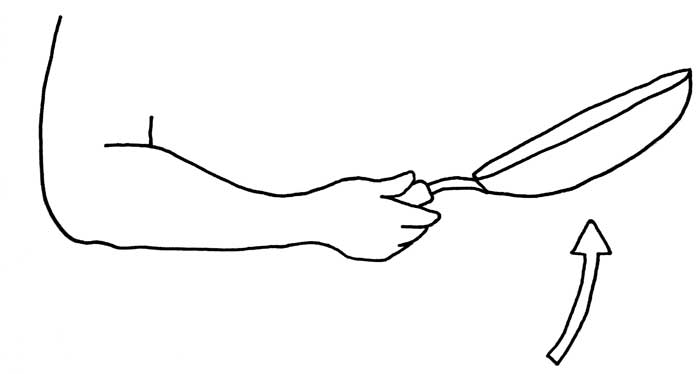
4 Lift the front of the pan at the end of the 6 inch extension.
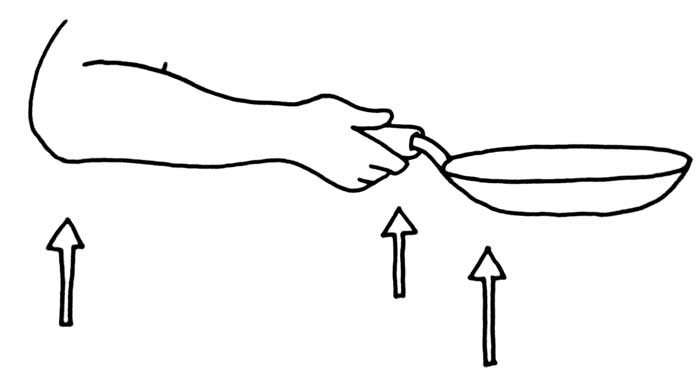
5 Continue to lift the pan up, about 3 inches.
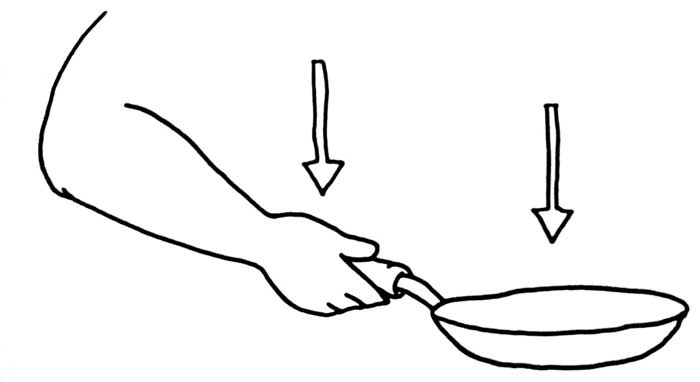
6 As you raise the pan, pull your arm back firmly to the original position.
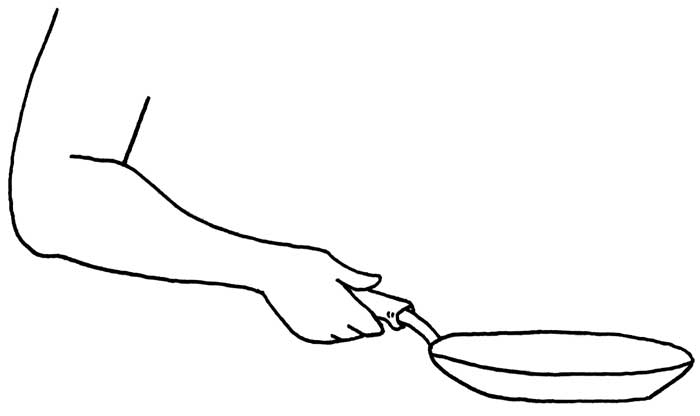
7 Catch your ingredients as they fall back down into the pan.

This motion is not a forwards and backwards motion. It is almost the exact same motion that a trains wheels make as they are rotated. Th ink about the drive arm on a steam train. It doesn’t go forwards and backwards. It moves in a circular direction. This techniques uses that same “chug-a-chug-a” motion to move the pan. If you move your arm statically forwards and backwards, you will either end up with a huge mess or achieve nothing at all. The flipping action is in the raising of the front of the pan. As your arm moves forward, it gives your ingredients forward velocity. By raising the pan at the end of the stroke, it changes the forward momentum into vertical momentum. This causes the ingredients to leave the pan, become airborne, and end up flipped and back into the pan. Most importantly, this technique does not require a large amount of force on your part. Applying too much force will end up with ingredients on your ceiling.
Mastery of this technique is mandatory, as its use is extremely common in many applications. This includes pancakes, omelets, and many other applications.
Homework: Practice Wrist Flipping with Dry Rice
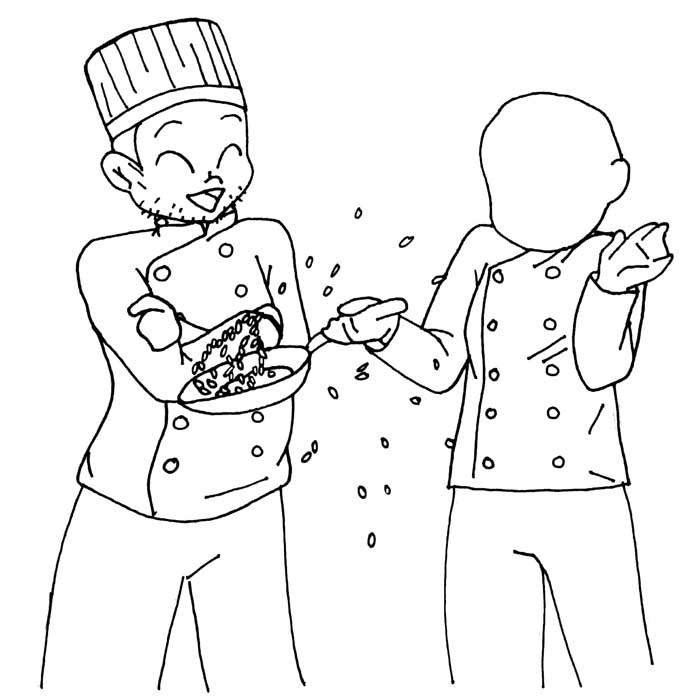
“It’s okay! Try Again!”
Your homework is to practice this technique in real life. Take a larger low-sided sauté pan and place 2 tablespoons of dry rice into it. Practice moving the rice around the pan and then slowly work up your confidence in the wrist motion by practicing what I have just taught you. Rice is the best medium to learn on because it is completely unforgiving. If you flip too hard, you will have rice on your floor. If you flip too soft, you will have rice on your floor. If you throw your arm forward
without lifting at the end, you will have rice on your floor. Basically, you are going to have a gigantic mess. So, make sure to have a broom handy. Practice this technique every day until you are extremely comfortable with it. It will not only bring you in tune with the technique, but it will harmonize the sauté pan as an extension of your own arm. This is the end goal of cooking. You need to feel like each piece of equipment is an extension of your own body. And when you feel like this, you will naturally develop an intuition and exceed the expectations that you could of ever had in your cooking proficiency.
Equipment Needed for Stir Fry Practice Recipes:
chef’s knife
medium size cutting board
large mixing bowl
small mixing bowl
measuring spoons
measuring cups
small sauté pan
large sauté pan
high heat spatula
colander
aluminum foil
rice cooker (optional)
Stir Fry Recipes
Beef and Broccoli
Fancy Instant Shrimp Ramen
Mapo Tofu
Teriyaki Chicken with Carmelized Onions and Peppers